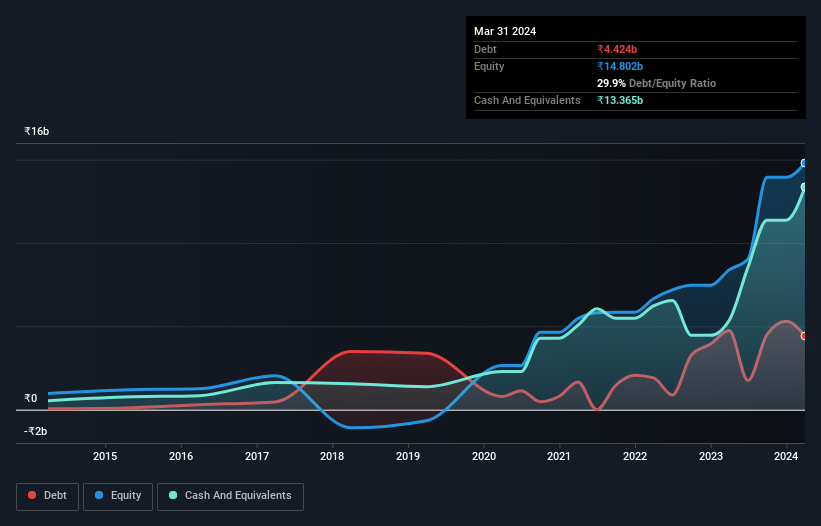Is Happiest Minds Technologies (NSE:HAPPSTMNDS) Using Too Much Debt?
Warren Buffett famously said, 'Volatility is far from synonymous with risk.' When we think about how risky a company is, we always like to look at its use of debt, since debt overload can lead to ruin. We note that Happiest Minds Technologies Limited (NSE:HAPPSTMNDS) does have debt on its balance sheet. But is this debt a concern to shareholders?
What Risk Does Debt Bring?
Debt assists a business until the business has trouble paying it off, either with new capital or with free cash flow. In the worst case scenario, a company can go bankrupt if it cannot pay its creditors. However, a more common (but still painful) scenario is that it has to raise new equity capital at a low price, thus permanently diluting shareholders. Having said that, the most common situation is where a company manages its debt reasonably well - and to its own advantage. When we examine debt levels, we first consider both cash and debt levels, together.
Check out our latest analysis for Happiest Minds Technologies
What Is Happiest Minds Technologies's Net Debt?
As you can see below, Happiest Minds Technologies had ₹4.42b of debt at March 2024, down from ₹4.75b a year prior. But it also has ₹13.4b in cash to offset that, meaning it has ₹8.94b net cash.

How Healthy Is Happiest Minds Technologies' Balance Sheet?
We can see from the most recent balance sheet that Happiest Minds Technologies had liabilities of ₹5.67b falling due within a year, and liabilities of ₹2.01b due beyond that. Offsetting this, it had ₹13.4b in cash and ₹2.55b in receivables that were due within 12 months. So it actually has ₹8.24b more liquid assets than total liabilities.
This surplus suggests that Happiest Minds Technologies has a conservative balance sheet, and could probably eliminate its debt without much difficulty. Succinctly put, Happiest Minds Technologies boasts net cash, so it's fair to say it does not have a heavy debt load!
On the other hand, Happiest Minds Technologies's EBIT dived 12%, over the last year. If that rate of decline in earnings continues, the company could find itself in a tight spot. There's no doubt that we learn most about debt from the balance sheet. But ultimately the future profitability of the business will decide if Happiest Minds Technologies can strengthen its balance sheet over time. So if you're focused on the future you can check out this free report showing analyst profit forecasts.
But our final consideration is also important, because a company cannot pay debt with paper profits; it needs cold hard cash. While Happiest Minds Technologies has net cash on its balance sheet, it's still worth taking a look at its ability to convert earnings before interest and tax (EBIT) to free cash flow, to help us understand how quickly it is building (or eroding) that cash balance. Over the most recent three years, Happiest Minds Technologies recorded free cash flow worth 53% of its EBIT, which is around normal, given free cash flow excludes interest and tax. This cold hard cash means it can reduce its debt when it wants to.
Summing Up
While it is always sensible to investigate a company's debt, in this case Happiest Minds Technologies has ₹8.94b in net cash and a decent-looking balance sheet. So we are not troubled with Happiest Minds Technologies's debt use. The balance sheet is clearly the area to focus on when you are analysing debt. However, not all investment risk resides within the balance sheet - far from it. For instance, we've identified 2 warning signs for Happiest Minds Technologies that you should be aware of.
When all is said and done, sometimes its easier to focus on companies that don't even need debt. Readers can access a list of growth stocks with zero net debt 100% free, right now.
Valuation is complex, but we're here to simplify it.
Discover if Happiest Minds Technologies might be undervalued or overvalued with our detailed analysis, featuring fair value estimates, potential risks, dividends, insider trades, and its financial condition.
Access Free AnalysisHave feedback on this article? Concerned about the content? Get in touch with us directly. Alternatively, email editorial-team (at) simplywallst.com.
This article by Simply Wall St is general in nature. We provide commentary based on historical data and analyst forecasts only using an unbiased methodology and our articles are not intended to be financial advice. It does not constitute a recommendation to buy or sell any stock, and does not take account of your objectives, or your financial situation. We aim to bring you long-term focused analysis driven by fundamental data. Note that our analysis may not factor in the latest price-sensitive company announcements or qualitative material. Simply Wall St has no position in any stocks mentioned.
About NSEI:HAPPSTMNDS
Happiest Minds Technologies
Provides information technology (IT) solutions and services in India, the Americas, Australia, Europe, Asia, the Middle East, and Africa.
Reasonable growth potential with adequate balance sheet.
Similar Companies
Market Insights
Community Narratives




